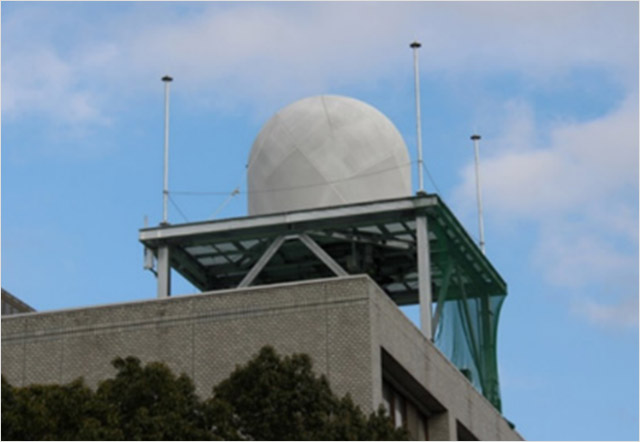Research HighlightsInnovation
January 2023 Issue
Meteorology Precipitation on the radar
Weather radars are important instruments for measuring precipitation. Traditional radars are based on a parabolic dish antenna. Mechanically rotating and tilting such an antenna takes a relatively long time, and as a result, parabolic-type radars can typically only perform sparse observations. So-called phased array weather radars (PAWRs) can obtain data with better spatial resolution much faster, as they consist of an array of smaller antennas that do not require to be moved. Hiroshi Kikuchi from the University of Electro-Communications, Tokyo, and colleagues have now analysed the performance of a next-generation PAWR based in Japan: the X-Band Dual Polarized PAWR (DP-DAWR), installed in 2017 at Saitama University. Specifically, they assessed the instrument’s accuracy of precipitation measurements by comparing with data obtained from a disdrometer (a device used for measuring raindrop sizes and velocities).
The Saitama University DP-DAWR simultaneously transmits fan-shaped beam pulses of horizontally and vertically polarized radiation at 9.425 GHz, which is in the so-called X-Band (8 – 12 GHz). The dual polarization improves the accuracy of precipitation amount measurements. In research mode, the instrument has a range of 60 km and the shortest temporal resolution is 10 seconds.
Measurements during a rainstorm demonstrated that the DP-DAWR can capture heavy rain at high temporal and spatial resolutions. This is useful in the context of monitoring and anticipating weather disasters in Japan such as flash flood events that are caused by locally generated heavy rain.
To quantify the accuracy of the performance of the radar, Kikuchi and colleagues compared observational data with radar variables derived from disdrometer data. The particle size and velocity (Parsivel) disdrometer used for this purpose is located 32 km away from the DP-DAWR, and provides raindrop size and speed distributions (32 size and 32 speed ranges are distinguished, resulting in 1024 raindrop types). From the disdrometer data, radar variables including the radar reflectivity factor could be calculated and compared to the observations made with the DP-DAWR. The comparison led to values for the mean and standard average of the radar reflectivity factor, a valuable characterization of the instrument’s accuracy.”
Finally, the researchers studied a thunderstorm event, and could conclude that the DP-PAWR is a convenient tool for observing the rapid growth of local convective thunderstorms, occurring often in Japan. Looking forward, Kikuchi and colleagues point out that in the near future, “quantitative evaluations of the DP-PAWR will be conducted using other precipitation types” and that in addition, “it is necessary to improve the signal processing for the high-reflectivity area near the edges of the different fan beams”.

Photograph of the DP-PAWR.
References
Hiroshi Kikuchi , Taku Suezawa, Tomoo Ushio, Nobuhiro Takahashi ,Hiroshi Hanado, Katsuhiro Nakagawa, Masahiko Osada, Tsuyoshi Maesaka, Koyuru Iwanami, Kazuhiro Yoshimi, Fumihiko Mizutani, Masakazu Wada and Yasuhide Hobara, Initial Observations for Precipitation Cores With X-Band Dual Polarized Phased Array Weather Radar, IEEE Transactions on Geoscience and Remote Sensing 58, 3657-3666 (2020).
- URL : https://ieeexplore.ieee.org/document/8949744
- DOI : 10.1109/TGRS.2019.2959628
Related publication
Hiroshi Kikuchi, Yasuhide Hobara, Tomoo Ushio, Compressive Sensing to Reduce the Number of Elements in a Linear Antenna Array With a Phased Array Weather Radar, IEEE Transactions on Geoscience and Remote Sensing 60, (2022).
- DOI : 10.1109/TGRS.2022.3152998


